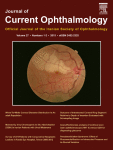White-to-white corneal diameter distribution in an adult population
Authors
Affiliations
1Noor Ophthalmology Research Center, Noor Eye Hospital, Tehran, Iran.
2Center for Health Related Social and Behavioral Sciences Research, Shahroud University of Medical Sciences, Shahroud, Iran.
3Department of Community Medicine, School of Medicine, Tehran University of Medical Sciences, Tehran, Iran.
4Department of Optometry, School of Paramedical Sciences, Mashhad University of Medical Sciences, Mashhad, Iran.
5Department of Epidemiology and Biostatistics, School of Public Health, Tehran University of Medical Sciences, Tehran, Iran.
Abstract
Purpose: To determine the normal distribution of corneal diameter in a 40- to 64-year-old population and its association with other biometric components.
Methods: In a cross-sectional population-based study, subjects were selected through multistage cluster sampling from the 40- to 64-year-old citizens of Shahroud in northern Iran. After obtaining informed consents, optometry tests including refraction and visual acuity and ophthalmic exams including slit lamp exams and retinoscopy were done for all participants. Biometric components and white-to-white (WTW) corneal diameter were measured with the LENSTAR/BioGraph.
Results: Of the 6311 invitees, 5190 (82.2%) participated in the study. After applying exclusion criteria, analysis was done on data from 4787 people. Mean WTW corneal diameter in this study was 11.80 mm (confidence interval: 11.78-11.81), and based on two standard deviations from the mean, the normal range for this index was from 10.8 to 12.8 mm. WTW corneal diameter strongly correlated with corneal radius of curvature (r = 0.422) and axial length (r = 0.384). According to multiple linear regression, lower age, thinner cornea, longer AL, thicker lens, and flatter cornea were significantly related to higher WTW corneal diameter. Spherical equivalent significantly increased at higher corneal diameters (hyperopic shift).
Conclusion: The average and normal range of corneal diameter, as measured with the BioGraph, was studied in an Iranian population for the first time. The corneal diameter strongly correlates with AL and radius of curvature. WTW is larger at younger ages.
Keywords: Adult; Corneal diameter; Cross-sectional study; Middle East.

